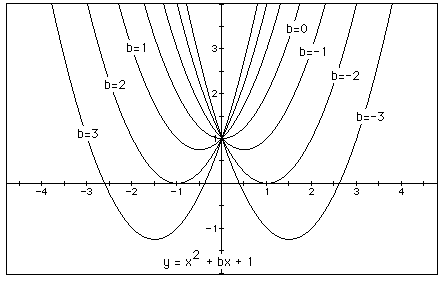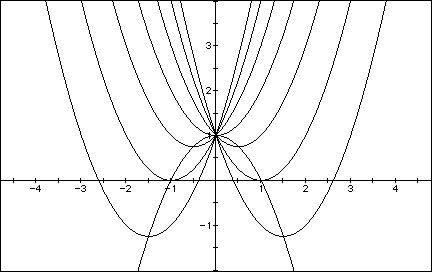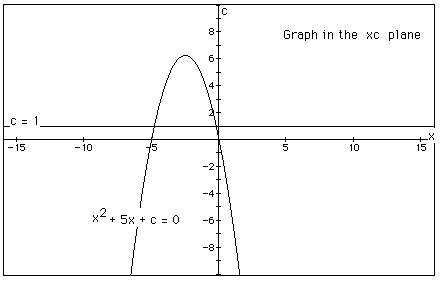

It has now become a rather standard exercise,
with availble technology, to construct graphs to consider the
equation
and to overlay several graphs of
for different values of a, b, or c as the other
two are held constant. From these graphs discussion of the patterns
for the roots (or where the graph touches the x-axis) of
can be followed. For example, if we set
for b = -3, -2, -1, 0, 1, 2, 3, and overlay
the graphs, the following picture is obtained.

We can discuss the "movement" of a parabola as b is changed. The parabola always passes through the same point on the y-axis ( the point (0,1) with this equation). The graph's behavior on the x-axis has three different trends, which translate into zero, one, or two roots for the equation.
1. For b < -2 the parabola will intersect the x-axis in two points with positive x values (i.e. the original equation will have two real roots, both positive). For b > 2, the parabola intersets the x-axis twice to show two negative real roots for each b.
2. For b = -2, the parabola is tangent to the x-axis and so the original equation has one real and positive root at the point of tangency. Similarly for b = 2 the parabola is tangent to the x-axis (one real negative root) and
3. For -2 < b < 2, the parabola does not intersect the x-axis -- the original equation has no real roots.
There will never be more than two roots because the equation's highest term is squared. The number of roots an equation has is less than or equal to the degree to which it is raised. A squared equation is a parabola, which can only cross the x-axis a maximum of 2 times due to its shape.
Now consider the locus of the vertices of the set of parabolas
graphed from
Following the vertices of the set of parabolas
as the value of b changes suggests that the locus is a parabola
that opens downward. The locus is the parabola



Consider again the equation
Now graph this relation in the xb plane. We
get the following graph.


For each value of b we select, we get a horizontal line. Similar to our previous results, the line can intersect the curve zero, one, or two times, meaning that there can be zero, one or two roots.
1. We get two negative real roots of the original equation when b > 2 and two positive real roots when b < -2, meaning that the horizontal line cuts through one of the curves twice.
2. We get one negative real root when b = 2 and one positive real root when b = -2, meaning that the horizontal line is tangent to the top of one of the curves.
3. We get no real roots for -2 < b <
2, meaning that the horizontal line never touches the curve.
Consider the case when c = - 1 rather than + 1, where the red
curves represent the graph and the green curves are asymptotes.

In this scenario, there will always be two roots. The blue horizontal line (which represents the value of b) can move up and down the y-axis and always touch the red curve in two places. There is no value of b where the horizontal line will be tangent to (with one root) or not touching (with no roots) the red curve. But why?
Let's consider what it means for a graph to have a c value of -1. This means that the vertex of the graph has a negative y value. The vertex is below the x-axis. The leading coefficient, x^2, is positive, meaning that the parabola faces upwards. If the vertex of the parabola is below the x-axis but the parabola faces upwards, the sides of the parabola will have to cross the x-axis, thus there will always be two real roots.
For example, consider the equation


When the vertex is below the x-axis, but opens
upwards, you can't avoid crossing the x-axis twice! Thus you will
always have two real roots.
This brings up an important relationship between the orientation of the parabola and the placement of the vertex. One of five things may occur with a parabola.
1. If the parabola faces upwards and its vertex is above the x-axis, then there are no real roots.
2. If the parabola faces downwards and its vertex is above the x-axis, then there will always be two real roots.
3. If the parabola faces upwards and its vertex is below the x-axis, then there will always be two real roots.
4. If the parabola faces downwards and its vertex is below the x-axis, then there are no real roots.
5. If the vertex lies on the x-axis, then there is only one real root, no matter the orientation of the parabola.
Graphs in the xc plane
In the following example the equation
is considered. If the equation is graphed in
the xc plane, it is easy to see that the curve will be a parabola.
For each value of c considered, its graph will be a line crossing
the parabola in 0, 1, or 2 points -- the intersections being at
the roots of the orignal equation at that value of c. In the graph,
the graph of c = 1 is shown. The equation
will have two negative roots -- approximately
-0.2 and -4.8.

Just as in previous examples, we can see that depending upon the value of c, there will be zero, one, or two roots.
1. For c > 6.25, the equation will have no real roots.
2.There is one value of c where the equation will have only 1 real root -- at c = 6.25, the vertex of the parabola.
3. For c < 6.25 the equation will have two roots. The roots are negative for 0 < c < 6.25, one negative and one 0 when c = 0, and one negative and one positive when c < 0.
The c value determines the y intercept of the
graph. When the graph faces upwards (like the one in this example),
and c is negative, then the vertex is below the x-axis. This means
that there are two real roots. There are also some positive values
of c for which there are two roots, meaning that the y intercept
is positive but the vertex is still below the x-axis. When the
value of c is 6.25, the vertex of the graph is directly on the
x-axis, so there is only one root. Any value of c that is higher
than 6.25 means that the vertex of the graph is above the x-axis.
As stated previously, a parabola that faces upwards with a vertex
above the x-axis has no real roots.